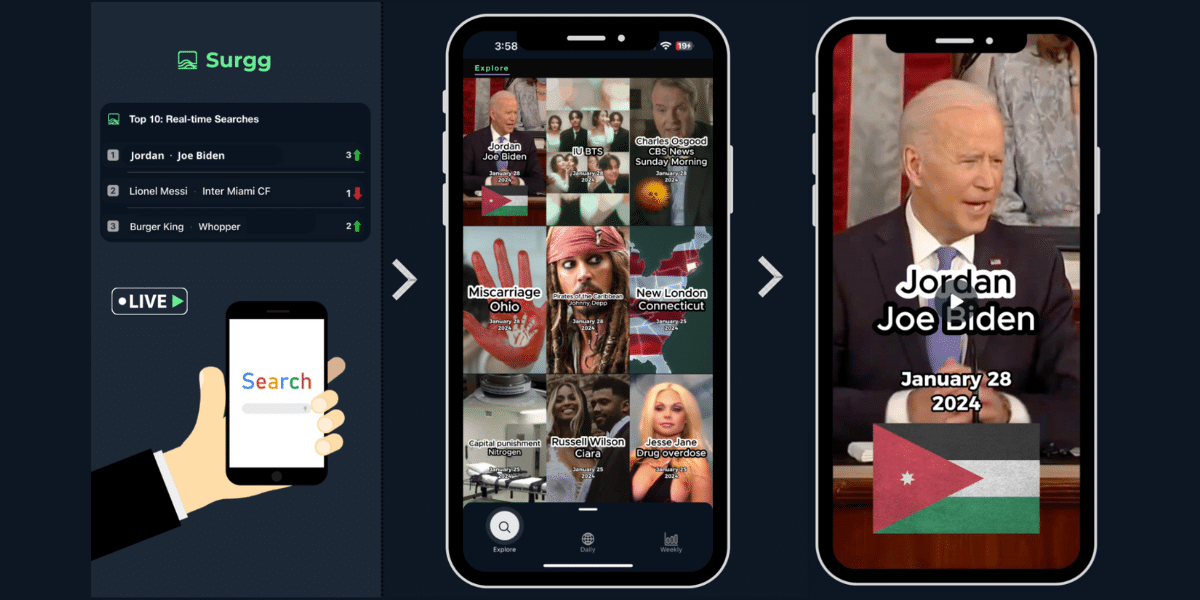What if the latest viral news stories and moments near you streamed in real-time video feeds?
Welcome to the future with Surgg.
Surgg is breaking from the mold of traditional news sources, which offer static articles and delayed coverage from the previous day. Instead, Surgg delivers the real-time visual content that Generation Z and millennial audiences crave.
Surgg has aligned itself with the need for urgency and visual engagement felt by younger demographics today by leveraging AI to instantly identify and explain emerging stories. It taps into Google Trends data to transform search trends into dynamic video briefs. Through its auto-generated, human-reviewed, and always-timely news, Surgg ensures users are informed the moment a news story sparks viral attention.
Surgg was founded by Jason Jin, a graduate of Columbia University and a current master’s student. He envisioned reinventing the way young audiences consume news by perfectly matching short viral videos to fleeting interests in their area. By using Surgg, one can tap into the pulse of their neighborhood – seeing what the community is discussing before headlines even emerge.
The main goals of Surgg?
A Vision for the Future of News Consumption
● Integration of real-time video feeds with AI to deliver trending news content instantly.
● Building user trust and engagement by consistently providing accurate and timely updates.
● Differentiating through real-time trend analysis and simplicity, learning from successful models like Naver (South Korean search engine).
● Aligning with the dynamic and real-time content consumption preferences of Generation Z and Millennials. With Surgg, users are no longer passive consumers of dated news articles.
Why Surgg Represents a Game-Changing Shift Towards Visual Social Media Browsing Platforms
Recent research from the Pew Research Center indicates that “YouTube remains the top platform among teens, followed by TikTok, Snapchat, and Instagram,” highlighting the popularity of visual platforms. Furthermore, they report that “About a third of U.S. adults under 30 now regularly get news on TikTok,” showcasing these platforms as mediums for information consumption.
The data is evident every day.
The number of TikTok users is growing steadily, and most users are reluctant to switch platforms. This makes it challenging to attract users to new apps given the vast number of options available.
TikTok’s success lies in its content variety and entertainment value. The reason for its growing downloads is simple: the way information is consumed by the younger generation is increasingly visual, dynamic, engaging, and concise, aligning with the fast-paced nature of modern life.
So why use Surgg instead of TikTok or other mainstream platforms?
The key differentiator is that while those apps rely on user-generated content, Surgg focuses on real-time generation of emerging news content. This represents Surgg’s unique value proposition, a game-changing shift towards on-demand social video browsing that keeps users informed of the latest happenings in a convenient and entertaining format.
Get Involved with Surgg
Surgg is transforming news consumption by utilizing AI-powered, real-time video content based on the most searched keywords from Google trends.
The prototype app from Surgg is currently available, offering users a glimpse into the future of news engagement.
Possessing significant scaling potential, Surgg is redefining the way the digital generation connects with news. The company invites individuals to join their movement, either as investors or enthusiasts, to influence the future of news.
The App is available for download now.
Google Play: link
Apple Store: link
Or visit our website to learn more: Website
Published By: Aize Perez

















